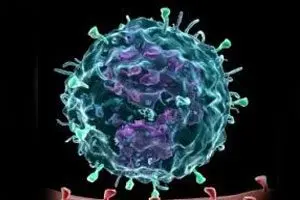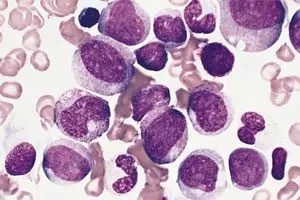Contents

Monocytes are blood cells that are part of the leukocyte group. Their number in the general structure of the leukocyte link is 2-10%. These cells are called orderlies of the human body. They have a high bactericidal activity, which is especially intense in the acidic environment of the body. If inflammation develops somewhere, then neutrophils are the first to go to the focus. Monocytes will be there a little later. They, like “wipers”, will remove all the consequences of the war: dead leukocytes and microbes, the remains of destroyed cells.
Monocytes capture and absorb even large cells, while they themselves die very rarely when they encounter pathogens. Therefore, monocytopenia, characterized by a decrease in the level of monocytes in the blood, may indicate a serious disease of the body.
Monocytopenia: norm or pathology?

Monocytes are agranulocytic leukocytes, that is, they do not contain granules. Their sizes exceed the sizes of all other blood cells. In diameter, monocytes reach 18-20 microns. Each monocyte contains an oval nucleus.
Normally, when a person is healthy, the level of monocytes in the blood is equal to 3-11% of all leukocytes. In addition, monocytes are present in the liver, spleen, bone marrow, and lymph nodes. There are much more of them than in the blood.
Produce monocytes in the bone marrow. From it, they enter the systemic circulation and circulate there in a free state for 2-3 days. Then their physiological death (apoptosis) occurs, or they are transformed into macrophages and sent to tissues. In the form of macrophages, monocytes will live in them for another 30-60 days.
Monocytopenia is characterized by a decrease in the level of monocytes below the normal range. This clinical and hematological syndrome accompanies a number of severe conditions and is not an independent pathology. Therefore, it can be unequivocally stated that monocytopenia is not a variant of the norm.
The level of monocytes in the blood varies depending on the age of the person. This indicator is characterized by the following values:
Newborn children up to 15 days – 5-15% of monocytes.
From 15 days to a year – 4-10%.
From one to two years – 3-10%
Starting from two years and up to 15 years – 3-9%.
For people over 15 years old – 3-11%.
There is no dependence of the level of monocytes on the gender of a person. The percentage of monocytes in the blood was given above. Absolute values can also have an impact on the correct diagnosis. For children under 12 years of age, these indications are equal to 0,05-1,1 * 109/ l. For adults, normal indicators are 0,04-0,08 * 109/ L.
Thus, a decrease in the level of monocytes below 2% for an adult is considered a deviation from the norm.
Causes of monocytopenia

Causes of monocytopenia can be as follows:
A purulent infection caused by a bacterial flora develops in the body.
A person has aplastic anemia.
In the body there is an oncological pathology of the hematopoietic system. Moreover, the disease develops over a long period of time and has reached a late stage.
A person is undergoing therapy with drugs that depress the functioning of the bone marrow.
Each of these reasons should be considered in more detail:
Purulent bacterial infection as a cause of monocytopenia. If staphylococci or streptococci multiply in the body, this will lead to a decrease in the level of monocytes in the blood. The most common infections accompanied by monocytopenia are: dermatological infections (boils, phlegmons and carbuncles), osteomyelitis with bone tissue damage, pneumonia of a bacterial nature, blood sepsis. Some purulent infections are able to be eliminated by the body on their own, and some require the mandatory intake of antibiotics. Otherwise, a person may die, for example, with sepsis. In addition to monocytopenia, an increase in the number of neutrophils will be observed in the blood test. Since these cells are the first to “attack” the microbial flora, concentrating in the focus of inflammation.
Aplastic anemia and monocytopenia. A decrease in the number of monocytes accompanies various forms of anemia. Anemia associated with iron deficiency responds well to treatment, while aplastic anemia is a serious condition that requires special attention. In this case, the body experiences a sharp slowdown or a complete halt in the growth and development of blood cells in the bone marrow. In particular, this applies to monocytes. Aplastic anemia is characterized by a violation of the hematopoietic system as a whole. If such patients do not receive treatment, then in a few months they will die.
Cancer and association with monocytopenia. Monocytopenia is manifested by leukemia. The late stage of this pathology is accompanied by inhibition of the work of all germs responsible for hematopoiesis. Therefore, there is a decrease not only in the number of monocytes, but also in other blood cells.
Drugs that can cause monocytopenia. Provoke monocytopenia can take corticosteroids and cytostatics. These drugs inhibit the work of the bone marrow, which leads to the development of pancytopenia.
Symptoms of monocytopenia

Monocytopenia itself does not manifest any symptoms, as this condition is not a separate disease. Therefore, the signs of monocytopenia must be considered through the prism of the pathology that provoked it.
With purulent-inflammatory processes in a person, the body temperature rises, chills develop. As a rule, patients are lethargic, complain of headaches and fatigue. Appetite often worsens, bowel function suffers, protein appears in the urine. Local symptoms of inflammation are determined by the stage of development of the pathological process and the place of its localization. The classic signs of such a reaction include redness, swelling, pain, high fever, and disruption in the functioning of one or another organ.
The leukemia clinic is as follows:
Hemorrhages in the skin and mucous membranes.
Marked weakness.
High body temperature.
Nausea and vomiting.
Hypertrophy.
Immunodeficiency, which often leads to the development of pneumonia and sepsis.
Aplastic anemia, accompanied by monocytopenia, is manifested by the following symptoms:
Decreased performance.
Strengthening weakness.
Pale skin.
Frequent dizziness.
An increase in heart rate.
Bleeding gums, internal hidden bleeding.
Decreased body defenses.
Frequent infectious diseases that are very difficult to cure.
Diagnosis of monocytopenia

Diagnosis of monocytopenia is not difficult. It is enough to pass a general blood test to determine the level of monocytes. These cells are included in the leukocyte blood formula, as they are a type of leukocyte.
Monocytes contain in their structure an oval nucleus, which has a bright color. It is thanks to this nucleus that it is possible to differentiate monocytes from lymphocytes. This is of great importance in laboratory diagnostics. In the analysis results, monocytes are identified by the abbreviation MON.
Recent surgeries and childbirth can affect the number of monocytes. Also, the cause of some decrease in the level of monocytes can be emotional exhaustion of the body.
Treatment of monocytopenia

Treatment of monocytopenia as a nosological unit does not make sense. It is impossible to increase the level of these blood cells without eliminating the cause that provoked their decrease. Therefore, therapy should be targeted, aimed at a specific disease.
Acute purulent processes require the patient to be placed in a hospital, where he will undergo intensive therapy. The patient is prescribed antibacterial drugs, if possible, purulent foci are drained. Immunomodulators and vitamins can help in treatment. The antibiotic is selected depending on the sensitivity of the microorganism to a particular drug, or broad-spectrum drugs are used.
Treatment of aplastic anemia involves an impact on the cause that provoked it. The patient may be prescribed hormonal and cytostatic drugs. In severe cases, a bone marrow transplant is required.
Patients with leukemia are hospitalized in oncology hospitals. The basis of treatment is polychemotherapy, which can be supplemented with erythrocyte or platelet mass transfusions, antibiotic therapy for infectious complications, intravenous infusions and hemosorption. A complete cure of the patient after bone marrow transplantation is possible.
When monocytopenia has been provoked by taking medications, they must be canceled. If this is done in a timely manner, then the functions of the bone marrow can be restored.
Monocytes, like other blood cells, are markers of a person’s health status. With a decrease in their number, it is necessary to conduct additional studies aimed at determining the cause of this violation. The diagnosis and selection of a therapeutic regimen is carried out not only taking into account laboratory data, but also on the basis of the clinic, which characterizes a particular disease.









